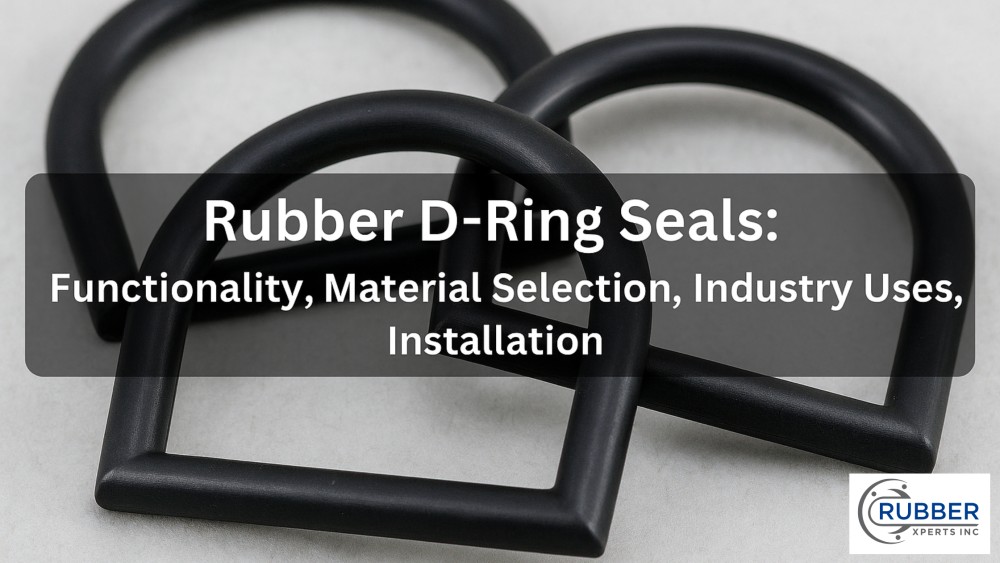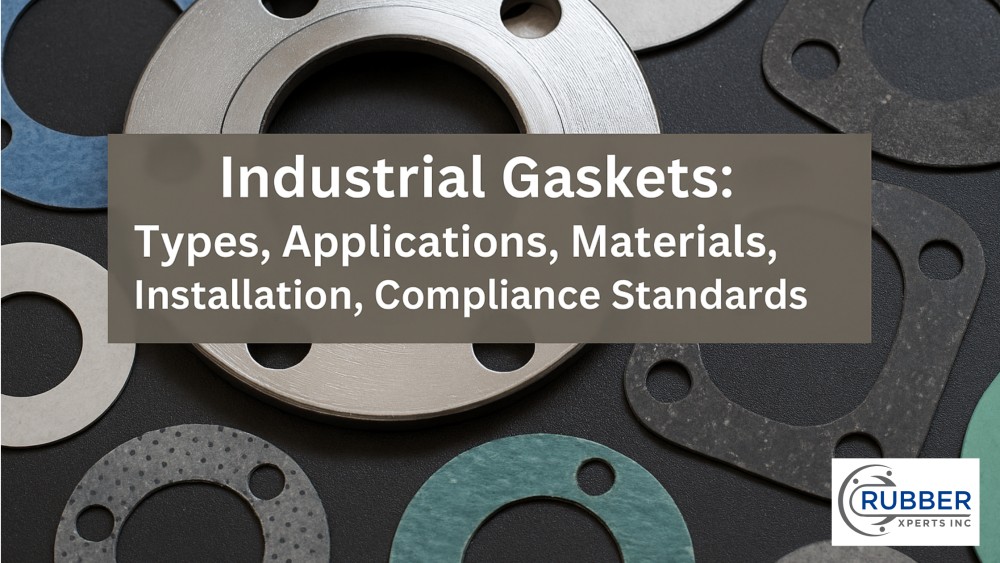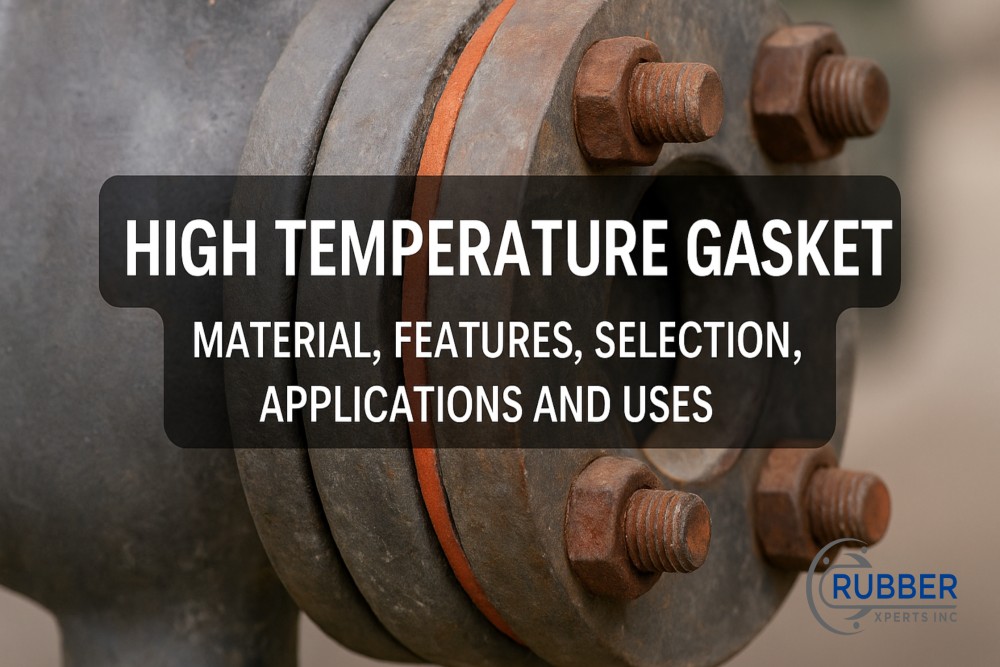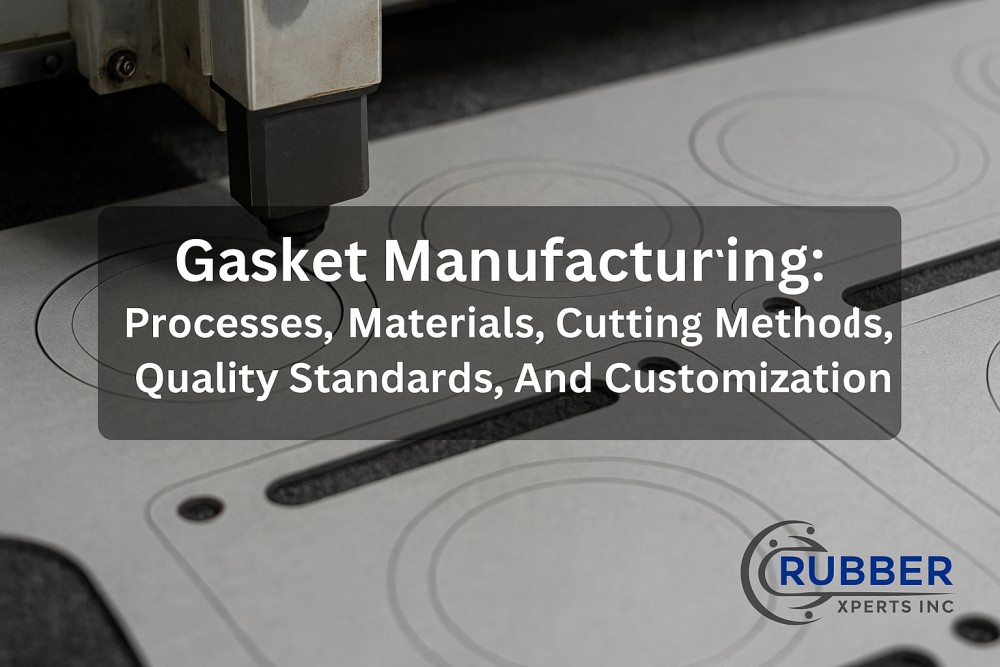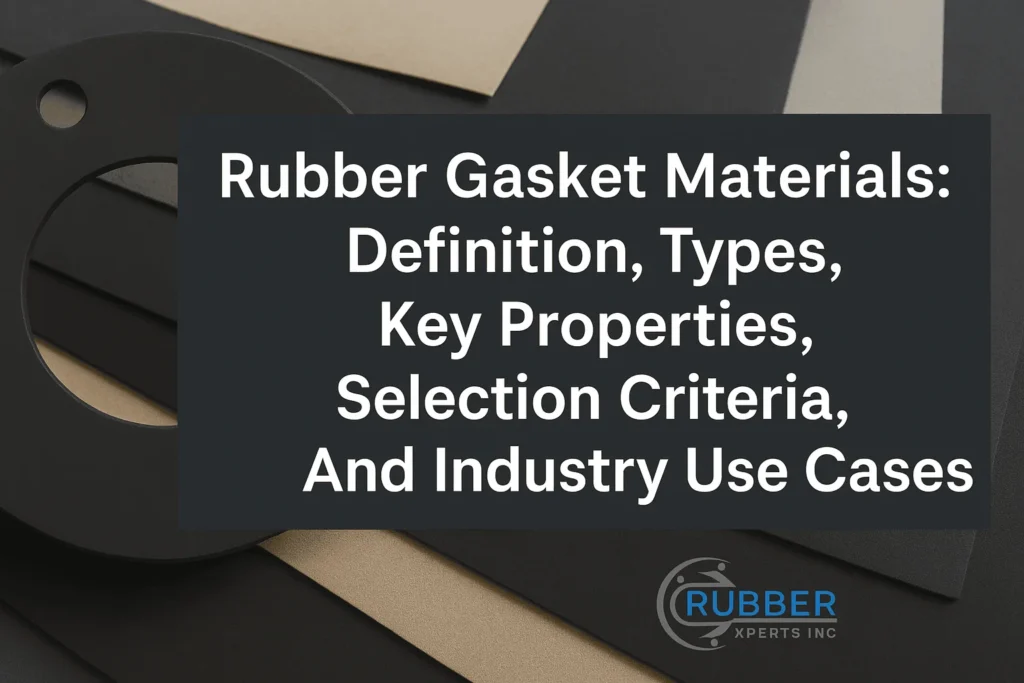The Rubber Manufacturing process changes raw rubber materials into diverse and functional products. Elastomers, with their unique flexibility, elasticity, and durability properties, provide integral solutions for sealing, vibration, and protection needs across various industries. According to a report by Precedence Research, the global rubber manufacturing industry, valued at $45.93 billion in 2023, is projected to grow at a 5.1% CAGR, reaching $79.38 billion by 2034.
The process of rubber manufacturing involves compounding, extrusion, and vulcanization. These processes ensure the creation of extruded parts and molded components that are necessary for industrial systems. Rubber’s role in sealing and preventing leaks enhances safety and reliability across applications.
The materials used in rubber manufacturing include natural latex, synthetic polymers, and additives like fillers and stabilizers. These materials are carefully selected and combined to improve the durability, resistance, and adaptability of the finished products to meet specific industrial demands.
Rubber manufacturing techniques include extrusion, injection molding, and calendering, which create precision-engineered products. These techniques are adapted based on the desired product’s shape, size, and application, ensuring optimal elasticity and flexibility for industries requiring custom solutions.
The equipment used for rubber manufacturing, like rubber mixers, extruders, and thermal solutions, ensures efficiency and quality during production. Advanced systems, including control systems and vulcanizers, transform polymeric materials into robust and reliable extruded parts and other components.
Quality control in rubber manufacturing is important to maintain consistency and performance. Rigorous testing and inspections at every stage ensure the durability and functionality of the final product. This focus on quality safeguards the integrity of products in demanding applications, delivering unmatched protection and reliability.
What is Rubber Manufacturing?
Rubber manufacturing is the process of producing rubber products from raw materials through a series of specialized techniques and methods customized to meet diverse industrial and consumer needs. This process converts natural or synthetic rubber into finished products, such as seals, gaskets, tires, and hoses, by using advanced technology and precision engineering.
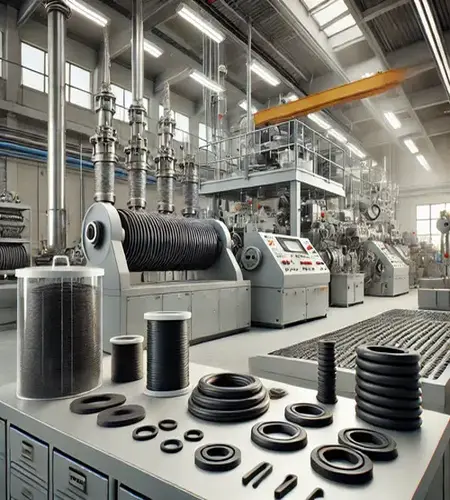
Rubber production involves various stages, including material preparation, shaping, curing, and finishing, to create durable and functional products for applications in the automotive, construction, healthcare, and electronics industries. Each stage employs distinct techniques and equipment, ensuring high-quality output while addressing specific performance requirements like elasticity, strength, and resistance.
What is the Process of Rubber Manufacturing?
The process of rubber manufacturing includes compounding, extrusion, and vulcanization, among other stages. These steps transform raw rubber into adaptable and durable rubber products suitable for various industrial applications, as studied by Sciencing. Each stage involves specialized techniques and equipment to ensure the rubber achieves the desired properties for its intended use.
The process of rubber manufacturing is explained as follows:
- Compounding
- Extrusion
- Calendering
- Vulcanization
- Latex Processing
- Polyurethanes
Compounding
Compounding is the first stage in the production of rubber products, where raw rubber is blended with additives to achieve desired properties. Using advanced techniques and methods, mixers, and mills act as the equipment to ensure uniform dispersion of fillers, plasticizers, and curing agents, as studied by K.S. Sisanth KS et 2017, titled “General Introduction to Rubber Compounding.”
These carefully controlled procedures improve the rubber’s durability, elasticity, and resistance to environmental factors. This step is foundational for creating materials customized to specific applications, such as automotive seals and industrial gaskets, ensuring high-quality finished products.
Extrusion
Extrusion transforms the compounded rubber into continuous profiles using an extrusion die. The feeding system and screw mechanism within the extruder ensure a consistent flow of material under precise pressure application, as studied by Industrial Quick Search in “Rubber Extrusion.” The heating or cooling system prevents degradation while maintaining process efficiency.
This step is required to produce cross-sectional profiles used in applications such as hoses, weatherstrips, and seals. Proper machines and quality control during this process ensure minimal waste and high-performance finished products.
Calendering
Calendering is a method in which rubber is passed through heated rollers to form sheets or coat fabrics. Elkem Magazine explains this process in “What is the calendering process?” The machines used in this stage apply controlled pressure and temperature, ensuring consistent thickness and surface finish.
This procedure is integral for creating products like conveyor belts and flooring. The techniques employed ensure the rubber achieves its intended durability and flexibility, making it suitable for industrial applications.
Vulcanization
Vulcanisation is a curing process in which raw rubber undergoes chemical transformation into a more robust material. Cross-linking agents like sulfur enhance elasticity and durability. This stage utilizes specialized equipment such as curing presses and autoclaves, and it involves precise heating systems and pressure applications.
According to a 2017 study by Progress in Rubber Nanocomposites titled ” Vulcanization, ” this procedure ensures quality control and produces reliable finished products for demanding applications like tires, seals, and vibration dampeners.
Latex Processing
Latex processing involves using liquid rubber materials like latex to create lightweight, flexible products. Techniques such as dipping and molding shape the material into items like gloves and medical devices.
The production process includes curing, during which the material gains durability and elasticity. Accurate quality control ensures that the finished products meet the stringent requirements of their applications.
Polyurethanes
Polyurethane rubber is produced through a chemical reaction between di-isocyanates and polyols. This process creates a highly durable and flexible material, requiring advanced machines and precise steps to achieve the desired balance between toughness and flexibility.
Polyurethane rubbers are widely used in applications such as industrial seals, rollers, and protective linings. Proper quality control during this stage ensures the reliability of the finished products.
What are the Materials Used in Rubber Manufacturing?
The materials used in rubber manufacturing are polymers, fillers, and plasticizers, which form the fundamental components of the rubber manufacturing process. These materials, combined with specialized additives, improve the rubber’s properties for diverse applications, such as sealing, vibration damping, and industrial protection.
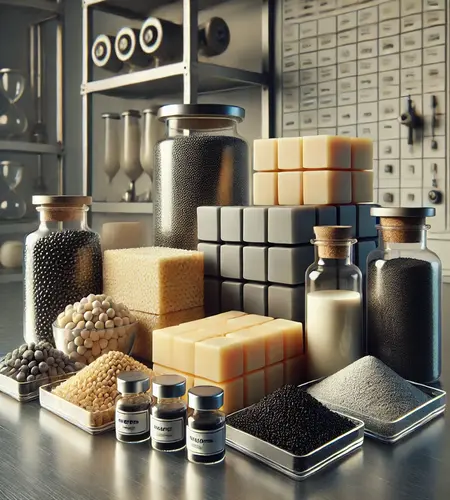
The materials used in rubber manufacturing are as follows:
Polymers
Polymers are the primary building blocks in rubber manufacturing. They consist of long-chain molecules that provide elasticity and durability to rubber products. Polymers include natural rubber derived from latex and synthetic rubbers like SBR and nitrile. The choice of polymer depends on the required flexibility, resistance, and application environment, such as automotive or industrial usage.
Fillers
Fillers are materials like carbon black and silica added to improve rubber’s strength, abrasion resistance, and overall performance. By reinforcing the polymeric material, fillers enhance rubber’s durability and elasticity, making it perfect for heavy-duty applications such as tires and conveyor belts. They also reduce production costs by acting as economical extenders.
Plasticizers
Plasticizers are additives that lower rubber’s viscosity to improve its flexibility and processability. Common plasticizers include phthalates and esters, which help achieve the desired softness and enhance the material’s performance in sealing and protection-based applications. They are important for producing rubber with superior adaptability.
Antidegradants
Antidegradants are chemicals that protect rubber from degradation caused by environmental factors such as ozone, UV light, and oxidation. These additives extend the durability and service life of rubber products used in harsh industrial environments, ensuring that rubber retains its performance under extreme conditions.
Antioxidants and Stabilizers
Antioxidants and stabilizers prevent the breakdown of rubber materials caused by heat and oxygen. These additives are important in maintaining the rubber’s elasticity and resistance to fatigue, making them integral to the manufacturing of finished products like seals, gaskets, and hoses.
Blowing Agents, Pigments, Bonding Agents
Blowing agents create cellular rubber products like foam, while pigments add color for aesthetic and identification purposes. Bonding agents ensure strong adhesion between rubber and other materials, enabling the creation of composite products like reinforced hoses. These materials enhance the diversity and functionality of rubber products.
What are the Different Techniques of Rubber Manufacturing?
The different techniques of rubber manufacturing include extrusion, molding, and calendering. These techniques are necessary for creating specialized products suchas seals, gaskets, and hoses. They utilize specific methods and equipment to transform raw materials into finished rubber goods suitable for diverse applications.
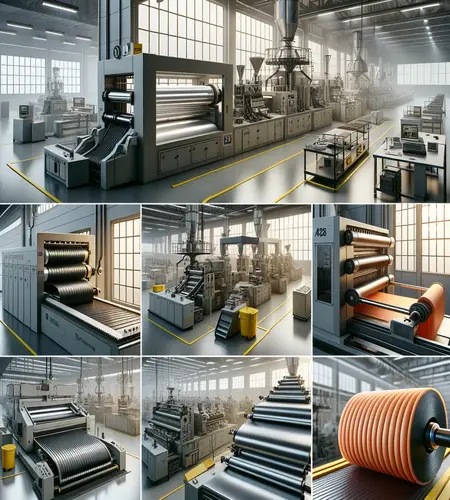
The different techniques of rubber manufacturing are as follows:
1 Rubber Extrusion
Rubber extrusion is a process where raw rubber is forced through an extrusion die using a screw mechanism to create continuous profiles with a uniform cross-sectional profile. This technique is commonly used to manufacture rubber extrusions like weatherstrips, seals, and tubing. The heating or cooling system ensures the rubber material is processed at optimal temperatures for flexibility and durability. This process delivers high-precision products suited for automotive, construction, and industrial uses.
2 Rubber Molding
Rubber molding involves shaping rubber into specific forms using compression, injection, or transfer molding techniques. The process starts with placing raw rubber or Liquid Silicone Rubber into a mold, which is then subjected to heat and pressure.
This method is fundamental for producing rubber-molded parts such as gaskets, O-rings, and vibration dampeners. Each type of molding—compression molding, injection molding, and transfer molding—offers unique advantages, such as reduced waste or better precision.
What are the Types of Rubber Molding?
The types of rubber molding are compression molding, injection molding, and transfer molding, which are widely used for producing gaskets, seals, and vibration dampeners. Each type has its unique techniques, applications, and benefits, making them integral to the rubber manufacturing industry.
The types of rubber molding are as follows:
- Compression molding: Compression molding involves placing raw rubber into an open mold and applying heat and pressure until the material conforms to the mold’s shape. This method is suitable for producing large parts with simple designs. It relies on an open mold, hydraulic press, and heating system. Compression molding is cost-effective for small production runs and works well with high-strength materials, but it offers limited precision and longer cycle times compared to other methods.
- Melt molding: This technique uses molten rubber poured or injected into a mold to form the desired shape. It is commonly employed to create lightweight and flexible products. This technique excels at handling complex geometries and reduces material waste. However, it requires precise temperature control and is less suitable for high-volume production.
- Transfer molding: Transfer molding pre-heats the rubber material and forces it into a closed mold through a transfer chamber, making it perfect for intricate parts with embedded components. This method ensures minimal flash and better dimensional control. Although it is effective for producing complex designs, the tooling costs for transfer molding are higher than those for compression molding.
- Injection molding: This technique injects molten rubber into a mold cavity under high pressure, making it a preferred method for mass-producing components like seals and O-rings. It is highly efficient and delivers consistent product quality for high-volume production. However, it has higher setup costs and requires precise control of material flow.
3 Rubber Calendering
Calendering is a rubber manufacturing technique that creates thin rubber sheets by pressing the material between heated rollers. This method is ideal for producing sealing membranes, conveyor belts, and coated fabrics.
The die-cutting process follows calendering, which shapes the sheets into specific sizes for various applications. Calendering ensures uniform thickness and adds dimensional stability to the rubber product, making it important for industries requiring high-quality sheets.
What are the Equipment Used in Rubber Manufacturing?
The equipment used in the rubber manufacturing process includes rubber mixers, hydraulic press systems, and thermal solutions, which are necessary for preparing raw materials, shaping rubber products, and ensuring durability through curing processes. These machines drive precision, efficiency, and quality across various rubber manufacturing methods.
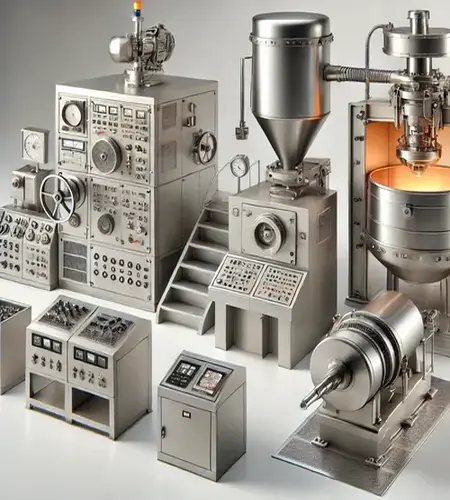
The equipment used in the rubber manufacturing are as follows:
Rubber Mixers
Rubber mixers, such as the Banbury mixer and two-roll mill, blend raw rubber with other additives to create a homogenous elastomeric compound. These machines ensure the consistent distribution of fillers, plasticizers, and curing agents. Rubber mixers also prepare materials for extruders and calendars to produce durable, high-quality seals and gaskets.
Hydraulic Press System
Hydraulic press systems are important for shaping rubber products through compression molding, transfer molding, and other techniques. These machines utilize high-pressure and controlled heat to create intricate parts like O-rings and vibration dampeners. Their precision and reliability make them indispensable in rubber production, enabling manufacturers to meet diverse application demands.
Thermal Solutions
Thermal solutions, including autoclaves and steam vulcanizers, cure and vulcanize rubber products. These systems use controlled heat and pressure to enhance rubber’s elasticity and durability, ensuring the final product meets the required specifications. Thermal solutions are particularly important in producing industrial hoses and automotive seals.
Advanced Control System
Advanced control systems, integrated with mixing and extrusion equipment, ensure precision at every stage of production. These systems monitor factors such as temperature, pressure, and flow rate, ensuring consistent quality. They are particularly useful in modern die-cutting machines to achieve precise cross-sectional profiles in products like rubber tubing.
Dewatering Screw Presses
Dewatering screw presses are employed in the processing of latex and other liquid polymeric materials. These machines extract moisture from the rubber compound, making it suitable for further processing. They are used in applications that require lightweight and flexible materials.
Mechanical Dryers
Mechanical dryers are necessary to remove residual moisture from rubber compounds after mixing or extrusion. By ensuring the material is adequately dried, these dryers maintain the integrity of the product during subsequent processing stages. They are paired with roll calendars to produce thin rubber sheets used in various industries.
How Safe is Rubber Processing Equipment?
Rubber processing equipment is safe when used according to proper protocols, regularmaintenance, and industry standards. Advanced design features, such as emergency shut-offs, safety guards, and automated systems to minimize human error, ensure the safety of these machines. These safety measures are important for preventing accidents in high-pressure environments associated with machinery like hydraulic presses and vulcanizing autoclaves.
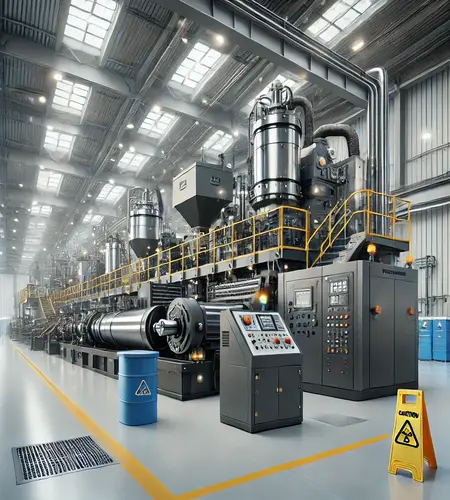
The equipment is designed to handle hazardous materials and processes, such as mixing rubber compounds or high-temperature vulcanization, in a controlled manner. Rubber mixers, for instance, are equipped with temperature regulation and pressure monitoring systems to prevent overheating and overpressurization, which lead to accidents. Cutting and trimming equipment, on the other hand, is fitted with safety features like blade guards to protect operators from accidental injuries.
To ensure a safe working environment, manufacturers must provide adequate training for operators, maintain equipment regularly, and comply with safety regulations specified by organizations such as OSHA and ISO. Implementing quality control protocols ensures the machine operates optimally, reducing the risk of malfunctions or unsafe conditions.
Why is Quality Control Important in Rubber Manufacturing?
Quality control is important in rubber manufacturing because it ensures that products meet the required standards, maintain consistent performance, and comply with industry regulations. Effective quality control prevents defects, reduces waste, and provides the durability and functionality of rubber products, which is important for customer satisfaction and cost management.
Quality control in rubber manufacturing is important for the following reasons:
Consistency and Reliability
Consistency and reliability in rubber manufacturing are achieved through systematic quality control processes. By monitoring and testing rubber materials throughout production, manufacturers ensure that the final products meet consistent specifications, such as elasticity, durability, and flexibility. This consistency is necessary for end users who require dependable performance in applications such as seals, gaskets, and automotive parts.
Safety and Compliance
Safety and compliance with industry regulations are fundamental to rubber manufacturing, especially when dealing with materials that undergo high-temperature processes or chemical treatments. Quality control ensures that the rubber products are free from hazardous defects and comply with safety standards.
It also helps manufacturers avoid legal issues by adhering to environmental regulations, such as those related to vulcanization and chemical resistance in rubber products, preventing unsafe products from reaching the market.
Customer Satisfaction
The quality of rubber products directly impacts customer satisfaction. By implementing stringent quality control measures, manufacturers ensure that products consistently meet customer requirements, whether for customized rubber extrusions or molded rubber components. High-quality products reduce returns and complaints, leading to stronger customer relationships and better market reputations.
Cost Efficiency
Effective quality control minimizes defects and reduces waste, achieving cost efficiency. By identifying issues early in the production process, manufacturers prevent costly reworks or scrapping of defective products. This also helps optimize material usage, reduce energy consumption, and ensure that production runs smoothly, eventually lowering manufacturing costs and improving profitability.
What Are the Key Components of Quality Control in Rubber Manufacturing?
The key components of quality control in rubber manufacturing are raw material inspection, process control, in-process testing, and final product testing. These components are important in ensuring the rubber products meet the required standards for performance, safety, and durability.
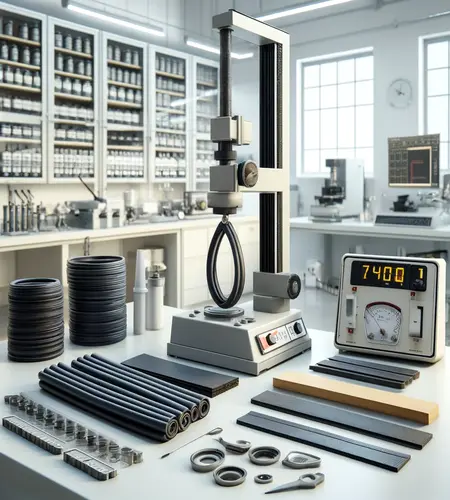
The key components of quality control in rubber manufacturing are as follows:
Raw Material Inspection
Raw material inspection is the first step in quality control. It ensures that the rubber materials entering the production process are of the highest quality. This process involves testing and assessing materials such as polymers, fillers, and additives to ensure that they meet the required specifications.
By inspecting materials for consistency, purity, and composition, manufacturers prevent defects in the final product and ensure the rubber’s expected flexibility, elasticity, and strength.
Process Control
Process control is the management of parameters during the rubber manufacturing process to ensure consistency and quality. This includes monitoring variables such as temperature, pressure, and vulcanization time during necessary stages like extrusion or molding.
Manufacturers maintain optimal production conditions and minimize variations by carefully controlling these factors that affect rubber’s performance in end-use applications such as seals, gaskets, or rubber hoses.
In-Process Testing
In-process testing involves assessing the rubber material at various stages of production to identify any deviations from the desired quality. This testing includes checking for density, hardness, or tensile strength during operations like molding or extrusion.
By conducting tests throughout the production process, manufacturers catch potential issues early, allowing for adjustments to be made to maintain the integrity of the product and prevent defects.
Final Product Testing
Final product testing is the last step in quality control. It involves thorough testing of the finished rubber products to ensure they meet the required specifications. This testing includes dimensional checks, mechanical properties tests, and performance evaluations, such as tear resistance or abrasion resistance.
By conducting these tests, manufacturers confirm that the final product performs as expected in real-world conditions and complies with industry standards. This ensures customer satisfaction and minimizes returns.
Can we Use Quality Management Systems for Quality Control in Rubber Manufacturing?
Yes, quality management systems (QMS) can be used for quality control in rubber manufacturing. Implementing a QMS, such as ISO 9001, ensures that all processes, from raw material inspection to final product testing, are consistently controlled and meet predefined standards.
These systems provide a structured framework for managing and improving quality. They help manufacturers systematically identify areas for improvement, ensure compliance with industry standards, and enhance overall product consistency.
How To Choose the Right Rubber Manufacturing Company?
To choose the right rubber manufacturing company, evaluate its capabilities, material sourcing, quality control processes, expertise, and solid reputation. This will ensure that your rubber products meet your specific requirements efficiently and reliably.
To choose the right rubber manufacturing company, the following things are considered:
Manufacturer’s Capabilities
The manufacturer’s capabilities are their ability to handle the specific production requirements of your project, including the type of rubber products you need, the volume, and the complexity of the design.
A company with advanced machinery, such as extrusion and molding equipment, offers more flexibility in production and customization. Ensuring the manufacturer meets your demands will help prevent delays and ensure high-quality output.
Material Sourcing
Material sourcing is an important factor in rubber manufacturing. A reputable company should have access to high-quality, reliable suppliers for the raw materials used in production.
Whether you require elastomers, fillers, or specific polymer types, the manufacturer should provide consistent material quality to ensure the final product meets performance standards. For long-term partnerships, companies that source materials responsibly and sustainably are preferable.
Quality Control Processes
Quality control is at the heart of rubber manufacturing. Ensure that the company has robust and well-defined quality control processes in place. These should include regular testing at different stages of production, from raw material inspection to the final product.
Companies with an established quality control process, such as adherence to ISO standards or other industry certifications, demonstrate their commitment to producing defect-free products that meet your specifications.
Expertise
A manufacturer’s expertise in rubber manufacturing is required to ensure the product’s performance and durability. Choose a company with a deep understanding of rubber materials, manufacturing techniques, and your application’s specific requirements.
Their expertise should include knowledge of advanced processes such as extrusion, molding, and curing. This knowledge ensures a smooth production process and high-quality output that meets industry standards.
Customer Testimonials
Customer testimonials provide valuable insight into a rubber manufacturer’s reliability and customer satisfaction. Positive feedback from previous clients helps confirm the company’s ability to meet deadlines, deliver quality products, and address customer concerns promptly.
Companies with long-term clients or a strong track record in the industry demonstrate a commitment to continuous improvement and customer satisfaction.
What are the Trends in the Rubber Manufacturing Industry?
The trends in the rubber manufacturing industry are largely shaped by advancements in technology, sustainability initiatives, and evolving customer demands. Innovations in automation, sustainable practices, and the development of high-performance materials are becoming increasingly important. Moreover, the growing demand for eco-friendly products, coupled with the integration of digital technologies in production processes, is driving significant changes in the industry.
As the focus on reducing environmental impact intensifies, many rubber manufacturers are adopting sustainable manufacturing practices, such as using recycled rubber biodegradable materials and reducing waste during production. These trends align with the growing preference for eco-conscious products across industries, including automotive, construction, and consumer goods.
Advanced automation and digitalization are revolutionizing rubber manufacturing, enabling companies to increase production efficiency, reduce human error, and enhance product customization. Integration of technologies such as artificial intelligence (AI), machine learning, and data analytics allows manufacturers to optimize processes, improve quality control, and predict maintenance needs.
Another notable trend is the development of high-performance materials tailored to meet the growing demands of industries such as aerospace, medical devices, and electronics. These industries require specialized rubber products that offer superior durability, resistance to extreme temperatures, and enhanced elasticity.
There is an increasing investment in research and development to create new and more advanced materials that cater to these specific needs. Smart manufacturing techniques, including 3D printing and precision molding, are enabling rubber manufacturers to deliver more customized products with complex designs, further expanding the scope of rubber applications across various sectors.
How Big is the Rubber Manufacturing Industry?
The rubber manufacturing industry is a substantial and growing sector within the global economy. It contributes significantly to various industries, such as automotive, construction, healthcare, and consumer goods. The global rubber manufacturing industry was valued at $45.93 billion in 2023 and is projected to reach $79.38 billion by 2034, driven by increasing demand in the automotive, construction, and healthcare sectors.
According to a report by Precedence Research, the industry is expected to grow at a compound annual growth rate (CAGR) of 5.1% from 2024 to 2034, reflecting its pivotal role in producing versatile, high-quality rubber products. This growth is driven by increasing demand for high-performance rubber products, advancements in manufacturing technologies, and rising applications across a wide range of industries.
The rubber manufacturing industry has experienced consistent growth due to its key role in producing important products such as tires, seals, gaskets, hoses, and medical devices. As industries become more dependent on materials that offer durability, flexibility, and resistance to various environmental factors, the demand for rubber continues to increase.
The market benefits from continuous innovation in rubber production techniques, including advancements in automation, sustainability, and the development of high-performance elastomers. This industry supplies the materials necessary for infrastructure, automotive, and manufacturing sectors, driving significant economic value worldwide.
Which US State Produces the Most Rubber?
Ohio produces the most rubber in the United States. The state leads in the rubber and plastics industry, with an annual production value of approximately $17.4 billion, according to Wikipedia.
Ohio’s prominence in rubber manufacturing is attributed to its robust infrastructure, skilled workforce, and the presence of major companies such as Goodyear Tire & Rubber, Parker Hannifin, and Cooper Tire & Rubber. These companies significantly contribute to the state’s production capacity, making Ohio a central hub for rubber manufacturing in the U.S.
The US states that produce most rubber are as follows:
|
State |
Number of rubber product manufacturing businesses |
|
Ohio |
180 |
|
California |
150 |
|
Texas |
72 |
What are the Most Common Products Produced by a Rubber Manufacturing Company?
The most common products produced by a rubber manufacturing company are rubber seals, rubber gaskets, and rubber hoses. These products are important in various industries, providing sealing, protection, and flexibility for many applications.
The most common products produced by a rubber manufacturing company are as follows:
- Rubber Seals: Rubber seals prevent the leakage of fluids or gases in mechanical systems. They are integral to industries such as automotive, aerospace, and plumbing, where maintaining pressure integrity is important. The material’s elasticity ensures an effective, long-lasting seal.
- Rubber Gaskets: Rubber gaskets form a tight seal between two mating surfaces, preventing liquids or gases from leaking. They are made from elastomers that withstand high pressure and temperature fluctuations and are used in numerous applications, such as automotive engines, industrial machinery, and HVAC systems.
- Rubber Hoses: Rubber hoses are flexible tubes designed to transport liquids, gases, or powders. They are commonly used in industries such as automotive, construction, and agriculture. Their versatility makes them ideal for applications requiring resistance to pressure, abrasion, and chemicals.
What are the Top Rubber Manufacturing Companies?
The top rubber manufacturing companies are Bridgestone, Michelin, Goodyear, Rubberxperts, and Continental. These companies are renowned for their advanced manufacturing techniques, diverse rubber product offerings, and industry leadership in producing high-quality rubber components for various applications.
The top rubber manufacturing companies are as follows:
- Bridgestone (Japan): Bridgestone is one of the world’s largest tire and rubber manufacturers, known for producing high-performance tires and rubber products. With a strong global presence, Bridgestone’s innovative technologies serve the automotive, industrial, and consumer sectors.
- Michelin (France): Michelin is a major player in the rubber industry, especially recognized for its tire manufacturing. The company also produces rubber-based products for the aerospace, agriculture, and industrial sectors, emphasizing sustainability and advanced material science.
- Goodyear (United States): Headquartered in Akron, Ohio, Goodyear is a leader in tire manufacturing and rubber products. Goodyear offers a wide range of products, from tires for cars to industrial rubber applications, that focus on quality and durability.
- Rubberxperts (United States): Rubberxperts is a leading manufacturer known for producing high-quality rubber components like seals, gaskets, and hoses. The company utilizes advanced rubber extrusion and molding techniques to deliver custom solutions to industries such as automotive, aerospace, and medical.
- Continental (Germany): Continental is a global leader in rubber and tire manufacturing, with a strong presence in the automotive and industrial markets. The company produces a wide range of rubber products, including tires, seals, and hoses, and emphasizes innovation and sustainability.

